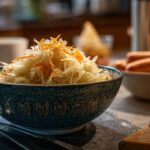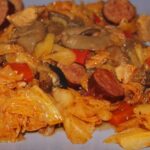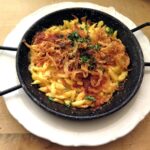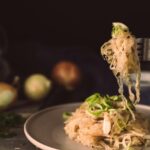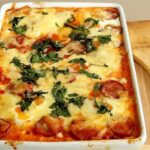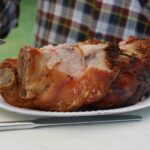A Bavarian Classic with a Tangy Twist
Few dishes capture the heart of German comfort food quite like Sauerkraut Cheese Spätzle. This rich, satisfying dish blends two culinary icons: Germany’s beloved hand-cut egg noodles (Spätzle) and the sharp, probiotic goodness of fermented cabbage (sauerkraut). Warm, cheesy, and full of bold flavor, it’s perfect for chilly evenings, Oktoberfest gatherings, or any time you’re craving authentic German soul food.
More than just a side dish, Sauerkraut Cheese Spätzle is a celebration of southern German flavors and homey traditions. Let’s explore how to make this crowd-pleaser at home – and why it deserves a permanent place in your German recipe rotation.
The Origins of Sauerkraut Cheese Spätzle
Spätzle has long been a staple in Swabian and Bavarian cuisine, dating back to the 18th century. Originally made by hand with a wooden board and scraper, these rustic noodles were a staple in peasant households due to their simplicity and filling nature. Over time, they became a national comfort food, especially in southern Germany, Austria, and Alsace.
The addition of cheese gave birth to Käsespätzle, often referred to as Germany’s answer to macaroni and cheese. The variation with sauerkraut likely evolved in regions where cabbage was abundant and fermented foods were part of daily life. Today, Sauerkraut Cheese Spätzle is a beloved regional twist enjoyed especially in Baden-Württemberg and Bavaria, where tangy kraut meets creamy cheese in a bubbling casserole.
Ingredients for Authentic Sauerkraut Cheese Spätzle
-
2 cups all-purpose flour
-
4 large eggs
-
1/2 tsp salt
-
1/4 cup milk (optional, for softer dough)
-
1 tbsp butter (for greasing)
-
1 tbsp vegetable oil (for cooking noodles)
-
1 1/2 cups German sauerkraut (rinsed and lightly drained)
-
1 large onion, thinly sliced
-
1 1/2 cups grated Emmental or Gruyère cheese
-
Salt and pepper to taste
-
Fresh chives or parsley for garnish (optional)
Suggested tools: Spätzle maker or colander with large holes, large pot, frying pan, casserole dish.
Substitutes: If you can’t find Emmental, use a blend of Swiss and sharp cheddar. Jarred sauerkraut works fine if rinsed and patted dry.
How to Make Sauerkraut Cheese Spätzle
Step 1: Prepare the Spätzle Dough
In a large mixing bowl, combine flour and salt. Beat in the eggs one at a time, then add milk until a thick but elastic batter forms. Stir vigorously or use a mixer with dough hooks for 3–5 minutes until bubbles form. Let rest for 15–30 minutes.
Step 2: Cook the Spätzle
Bring a large pot of salted water to a boil. Using a Spätzle press or colander, press the dough through into the boiling water. Cook in batches – when the noodles float to the top, they’re done. Scoop them out with a slotted spoon and toss lightly in oil to prevent sticking.
Step 3: Sauté the Onion and Sauerkraut
In a large frying pan, melt butter over medium heat. Add the sliced onion and cook until golden brown and caramelized (about 10–12 minutes). Add the sauerkraut and cook for 5 more minutes, stirring occasionally. Season with salt and pepper to taste.
Step 4: Assemble and Bake
Preheat your oven to 190°C (375°F). In a buttered casserole dish, layer the cooked Spätzle, sauerkraut-onion mixture, and cheese. Repeat layers until all ingredients are used, finishing with a generous topping of cheese.
Step 5: Bake Until Golden
Bake uncovered for 15–20 minutes, or until the top is bubbling and lightly golden. Let sit for 5 minutes before serving. Garnish with chopped chives or parsley for a pop of color.
Tip: Avoid overcooking the sauerkraut – its texture and tanginess should shine through the creamy cheese.
How to Serve Sauerkraut Cheese Spätzle
Sauerkraut Cheese Spätzle is typically served hot from the oven as a main dish, especially in the colder months. For a complete German meal, pair it with:
-
Red cabbage or mustard greens
For drinks, opt for a chilled Helles lager or a dry Riesling – the acidity helps cut through the richness of the cheese and kraut.
Variations & Regional Twists
In Bavaria, cooks sometimes add smoked bacon or speck between layers for extra savoriness. In Swabia, milder cheeses like Bergkäse may be used. Other regional or modern variations include:
-
Spicy version: Add a pinch of chili flakes or smoked paprika.
-
Creamy version: Stir in a bit of crème fraîche before layering.
-
Vegetarian version: Use plant-based cheese and sautéed mushrooms in place of sausage.
-
Holiday twist: Add roasted chestnuts or apple slices for a festive touch.
Feeling creative? Try pairing it with our German Sauerkraut with Apples for a sweet-savory contrast.
A Dish Worth Repeating
Sauerkraut Cheese Spätzle is a warm embrace in casserole form. It combines the comfort of home-cooked noodles, the richness of melting cheese, and the unmistakable zing of sauerkraut – all in one unforgettable bite. Whether you’re exploring German cooking for the first time or looking to impress with an authentic recipe, this dish is sure to win hearts (and stomachs).
Craving more German flavors? Try our Bratwurst Sauerkraut Casserole, Roast Pork and Sauerkraut, or browse our complete Sauerkraut Recipe Collection!
Related articles:
How Sauerkraut Became Germany’s Superfood
Learn how sauerkraut became Germany’s nutritional powerhouse. Discover its health benefits, cultural history, and delicious German recipes to try.
Easy Homemade German Spaetzle Recipe
Mushroom Spätzle Pan

